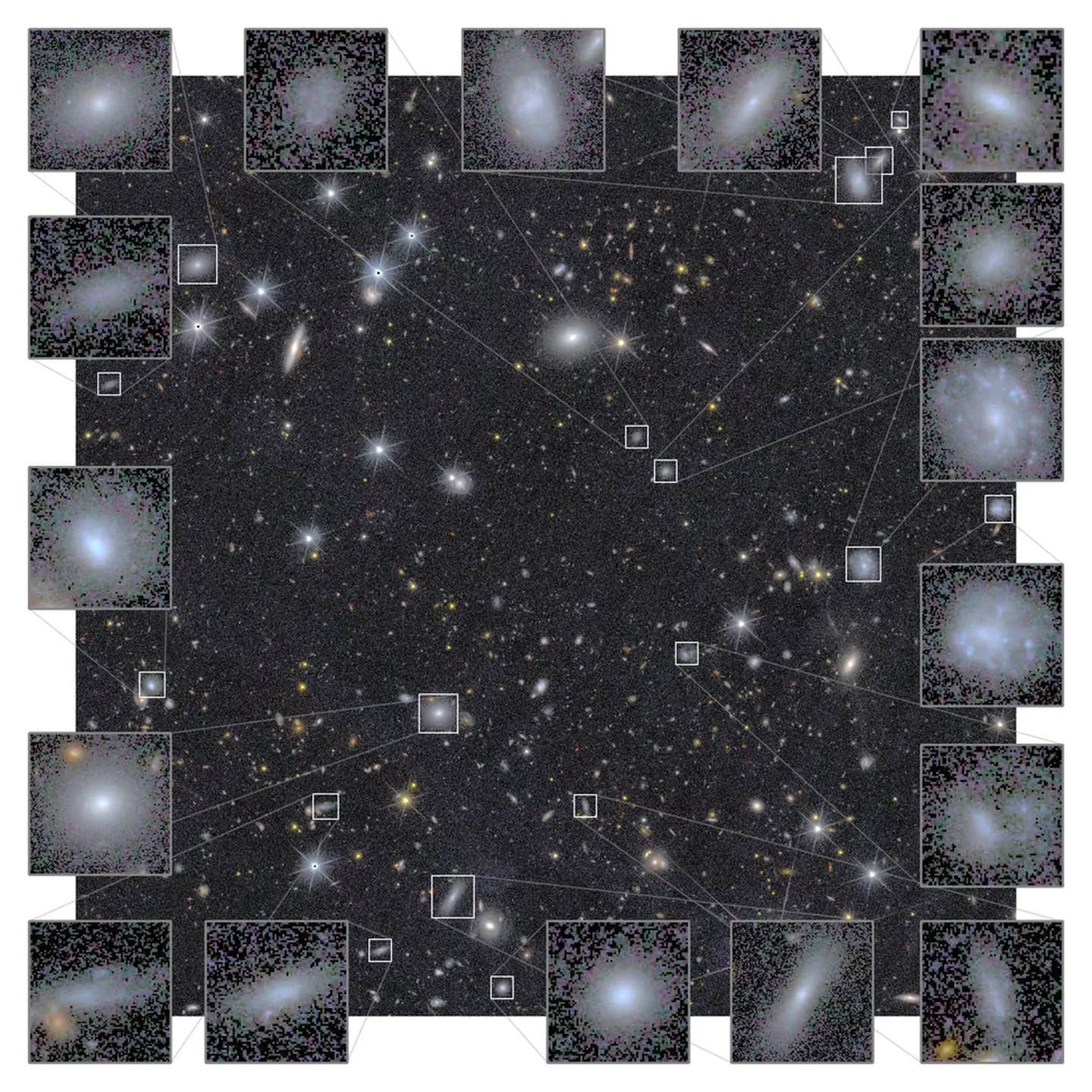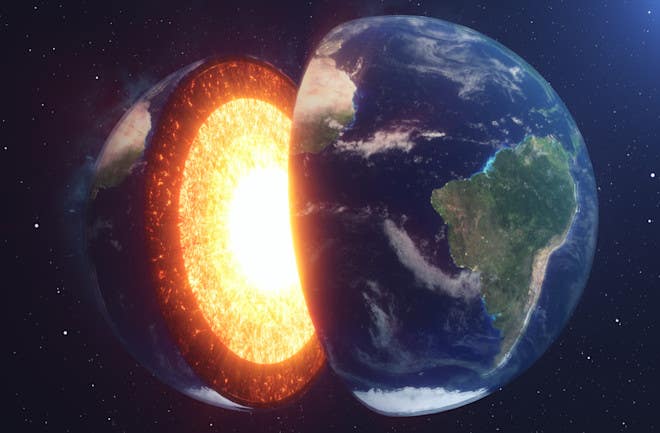Euclid space telescope discovers thousands of hidden dwarf galaxies
The Euclid space telescope has found thousands of dwarf galaxies, offering fresh insight into dark matter and galaxy evolution.

Some of the dwarf galaxies discovered in the Euclid images. (CREDIT: arXiv)
A whole universe of hidden galaxies lies just beyond what the eye can see. Thanks to a new generation of space telescopes, astronomers are now revealing these distant, dim worlds—some no bigger than a fraction of the Milky Way but holding clues to how the universe took shape.
Dwarf galaxies, the most common galaxies in the cosmos, are small and faint. They often go unnoticed next to brighter, larger galaxies. But they matter. These galaxies are considered the building blocks of the universe. Understanding them helps scientists test how galaxies form, evolve, and gather stars over time.
What Makes Dwarf Galaxies Special?
Dwarf galaxies usually have a total stellar mass of less than one billion suns. That’s a fraction of what a large galaxy contains. For comparison, the Large Magellanic Cloud, just barely above that threshold, is often used as a benchmark.
These galaxies come in many forms. Some are filled with young, bright stars, while others have stopped forming new ones. The main difference is whether they still create stars or if their gas has been stripped away.
Late-type dwarf galaxies include those still forming stars. These are often called dwarf irregulars or blue compact dwarfs, depending on how active their star formation is.
On the other hand, early-type dwarf galaxies are "quenched," meaning they’ve stopped producing stars. These include dwarf ellipticals, dwarf spheroidals, ultra-diffuse galaxies (UDGs), ultra-faint dwarfs, and ultra-compact dwarfs (UCDs). Some even have dense central nuclei, while others do not.
One major trait that sets dwarf galaxies apart from star clusters is the presence of dark matter. Star clusters don’t contain dark matter, but dwarf galaxies do, making this an important way scientists tell the two apart.
How Environment Shapes Galaxies
Where a dwarf galaxy lives in the universe affects its shape and how it behaves. Those found in crowded areas—like clusters of galaxies—tend to be early-type galaxies that no longer form stars. But late-type dwarfs are often found in more isolated areas, known as the field.
Related Stories
Several physical forces can quench a galaxy, or stop it from forming stars. One process, called ram-pressure stripping, occurs when a dwarf galaxy moves through hot gas in a cluster. This gas pressure pushes the star-forming material out of the galaxy.
Another process, tidal harassment, happens when gravity from nearby galaxies pulls and stretches a dwarf galaxy, removing its gas. A third mechanism, starvation, slowly cuts off the gas supply from the galaxy’s surroundings, making new star formation impossible.
While these forces are common in dense clusters, they don’t tell the whole story. Recent studies have found large numbers of quenched dwarf galaxies even in medium-density environments. That suggests multiple paths lead to their formation.
Seeing the Unseen
Dwarf galaxies are tough to find. They are small and give off very little light, often blending into the background of deep-space images. In the past, astronomers had to search for them manually, studying images by eye. This method was slow and covered only small areas of the sky.
To speed up the process, researchers started using semi-automated software tools like SourceExtractor and NoiseChisel. These programs scan telescope data and flag possible dwarf galaxy candidates. But even these methods still need human review to avoid false positives. Bright stars or large galaxies nearby can easily mask a dwarf.
So far, no fully automated system can create a clean, complete catalogue of dwarf galaxies without human help. That’s a major challenge as sky surveys continue to expand.
A New Tool in the Sky
The Euclid space telescope, launched by the European Space Agency in July 2023, is changing the game. Euclid is designed to observe one-third of the sky in both visible and near-infrared light. Its two powerful instruments, VIS and NISP, provide sharp, wide-field images that can detect even the faintest objects.
The telescope’s strength lies in its combination of deep imaging, wide coverage, and excellent resolution. In its Wide Survey mode, Euclid can spot galaxies with a surface brightness down to 29.8 magnitudes per square arcsecond. In its Deep Survey mode, that number climbs to 31.8—some of the faintest light levels ever observed. These capabilities make Euclid a powerful tool for finding previously hidden dwarf galaxies.
Already, its performance has been remarkable. In just 25 images, a team led by Francine Marleau at the University of Innsbruck identified 2,674 dwarf galaxies. Her group used a semi-automated approach to scan the data and compiled a catalogue of candidates.
Of those galaxies, 58% were elliptical dwarfs, and 42% were irregular. A few had special features—1% had globular clusters, 4% had galactic nuclei, and nearly 7% had bright blue centers.
“These galaxies help us test our models of the universe,” said Marlon Fügenschuh and Selin Sprenger, two researchers from the team.
Unlocking Cosmic Mysteries
Dwarf galaxies help scientists test cosmological models. Their number, types, and locations in the sky offer vital data for theories about how galaxies form and grow.
By studying these galaxies, researchers can learn how dark matter shapes the cosmos. Dark matter, which doesn’t emit or reflect light, is believed to play a major role in galaxy formation. Dwarf galaxies are especially useful in this research because they are dominated by dark matter, making the effects easier to see.
"We took advantage of the unprecedented depth, spatial resolution, and field of view of the Euclid data," Marleau said. "This work highlights Euclid’s remarkable ability to detect and characterize dwarf galaxies, enabling a comprehensive view of galaxy formation and evolution across diverse mass scales, distances, and environments."
The Euclid mission is also central to studying dark energy—the mysterious force causing the universe to expand faster over time. By creating a 3D map of billions of galaxies, Euclid can show how structures in the universe have evolved. That will help scientists understand the role of gravity and the behavior of dark energy and dark matter.
A Telescope for the Future
Euclid’s mission will continue for years. The telescope is expected to observe over 14,000 square degrees of the sky and detect around a million new dwarf galaxies. Among them could be tens of thousands of ultra-diffuse and ultra-compact dwarfs, each providing new clues about the universe.
So far, the telescope has already delivered strong results. Early data releases have revealed new dwarf galaxies in places like the Perseus and Fornax clusters, as well as the Dorado group. Scientists have also identified rich globular cluster systems and faint structures in nearby galaxies.
Over 2,000 scientists from nearly 300 labs and institutes worldwide are analyzing the data. Some use ground-based telescopes to support the work. Together, this global team is pushing the boundaries of what we know about the cosmos.
As new tools like Euclid continue to explore the night sky, they are helping rewrite the story of galaxy formation. Hidden worlds are being uncovered—tiny but mighty, and filled with cosmic secrets that stretch back to the dawn of time.
Research paper "Euclid: Quick Data Release (Q1) -- A census of dwarf galaxies across a range of distances and environments" is available to view at arXiv.
Note: The article above provided above by The Brighter Side of News.
Like these kind of feel good stories? Get The Brighter Side of News' newsletter.
Joshua Shavit
Science & Technology Writer | AI and Robotics Reporter
Joshua Shavit is a Los Angeles-based science and technology writer with a passion for exploring the breakthroughs shaping the future. As a contributor to The Brighter Side of News, he focuses on positive and transformative advancements in AI, technology, physics, engineering, robotics and space science. Joshua is currently working towards a Bachelor of Science in Business Administration at the University of California, Berkeley. He combines his academic background with a talent for storytelling, making complex scientific discoveries engaging and accessible. His work highlights the innovators behind the ideas, bringing readers closer to the people driving progress.



